- Clone
- B1 (See other available formats)
- Regulatory Status
- RUO
- Other Names
- T cell receptor γ/δ, γ/δ TCR, TCR-γ/δ
- Isotype
- Mouse IgG1, κ
- Ave. Rating
- Submit a Review
- Product Citations
- publications
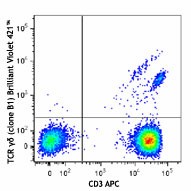
-

Human peripheral blood lymphocytes were stained with CD3 APC and TCR γ/δ (clone B1) Brilliant Violet 421™ (top) or mouse IgG1, κ Brilliant Violet 421™ isotype control (bottom). -

| Cat # | Size | Price | Quantity Check Availability | Save | ||
|---|---|---|---|---|---|---|
| 331217 | 25 tests | 164€ | ||||
| 331218 | 100 tests | 326€ | ||||
T cell receptor (TCR) is a heterodimer consisting of an α and a β chain (TCR α/β) or a γ and a δ chain (TCR γ/δ). TCR γ/δ is involved in the recognition of certain bacterial, self-CD1 molecule, and tumor antigens bound to MHC class I. The γ/δ TCR associates with CD3 and is expressed on a subset of T cells found in the thymus, the intestinal epithelium, and the peripheral lymphoid tissues and peritoneum. Most γ/δ T cells are CD4-/CD8-, some are CD8+. T cells expressing the γ/δ TCR have been shown to play a role in oral tolerance, innate immune response for some tumor cells, and autoimmune disease. It has been reported that γ/δ T cells also play a principal role in antigen presentation.
Product DetailsProduct Details
- Verified Reactivity
- Human, Cynomolgus, Rhesus
- Reported Reactivity
- African Green, Baboon, Pigtailed Macaque
- Antibody Type
- Monoclonal
- Host Species
- Mouse
- Formulation
- Phosphate-buffered solution, pH 7.2, containing 0.09% sodium azide and BSA (origin USA).
- Preparation
- The antibody was purified by affinity chromatography and conjugated with Brilliant Violet 421™ under optimal conditions.
- Concentration
- Lot-specific (to obtain lot-specific concentration and expiration, please enter the lot number in our Certificate of Analysis online tool.)
- Storage & Handling
- The antibody solution should be stored undiluted between 2°C and 8°C, and protected from prolonged exposure to light. Do not freeze.
- Application
-
FC - Quality tested
- Recommended Usage
-
Each lot of this antibody is quality control tested by immunofluorescent staining with flow cytometric analysis. For flow cytometric staining, the suggested use of this reagent is 5 µl per million cells in 100 µl staining volume or 5 µl per 100 µl of whole blood.
Brilliant Violet 421™ excites at 405 nm and emits at 421 nm. The standard bandpass filter 450/50 nm is recommended for detection. Brilliant Violet 421™ is a trademark of Sirigen Group Ltd.
Learn more about Brilliant Violet™.
This product is subject to proprietary rights of Sirigen Inc. and is made and sold under license from Sirigen Inc. The purchase of this product conveys to the buyer a non-transferable right to use the purchased product for research purposes only. This product may not be resold or incorporated in any manner into another product for resale. Any use for therapeutics or diagnostics is strictly prohibited. This product is covered by U.S. Patent(s), pending patent applications and foreign equivalents. - Excitation Laser
-
Violet Laser (405 nm)
- Application Notes
-
Clone B1 is also known as clone B1.1.
Additional reported applications (for the relevant formats) include: immunohistochemical staining of acetone-fixed frozen sections3 and paraffin-embedded sections5, in vitro blocking, and spatial biology (IBEX)8,9. The Ultra-LEAF™ purified antibody (Endotoxin < 0.01 EU/µg, Azide-Free, 0.2 µm filtered) is recommended for highly sensitive assays (Cat. Nos. 331235 and 331236). - Application References
-
- Rodriguez-Gago M, et al. 2001. Transplantation. 72:503.
- Lehmann FS, et al. 2002. Am. J. Physiol. Gastrointest. Liver. Physiol. 283:G481. (FC)
- Bordignon M, et al. 2008. Mol. Med. Rep. 1:485. (IHC)
- Conrad M, et al. 2007. Cytom. Part A 71A:925. (FC)
- Pollinger B, et al. 2011. J. Immunol. 186:2602. (IHC)
- Correia DV, et al. 2011. Blood. 118:992. (Block)
- Laurent AJ, et al. 2014. PLoS One. 9:103683. PubMed
- Radtke AJ, et al. 2020. Proc Natl Acad Sci USA. 117:33455-33465. (SB) PubMed
- Radtke AJ, et al. 2022. Nat Protoc. 17:378-401. (SB) PubMed
- Product Citations
-
- RRID
-
AB_2562316 (BioLegend Cat. No. 331217)
AB_2562317 (BioLegend Cat. No. 331218)
Antigen Details
- Structure
- Ig superfamily, associates with CD3 complex
- Distribution
-
T subset in thymus, intestinal epithelium, peripheral lymphoid tissues and peritoneum
- Function
- Antigen recognition
- Ligand/Receptor
- Some bacterial or tumor antigens bound MHC class I, CD1 molecule
- Cell Type
- Epithelial cells, T cells
- Biology Area
- Adaptive Immunity, Immunology
- Molecular Family
- TCRs
- Antigen References
-
1. Lanier LL, et al. 1987. J. Clin. Immunol. 7:429.
2. Spencer J, et al. 1989. Eur. J. Immunol. 19:1335.
3. Uyemura K, et al. 1991. J. Exp. Med. 174:683.
4. Spada FM, et al. 2000. J. Exp. Med. 191:907. - Gene ID
- 6964 View all products for this Gene ID 6965 View all products for this Gene ID
- UniProt
- View information about TCR gamma/delta on UniProt.org
Related FAQs
- What is the F/P ratio range of our BV421™ format antibody reagents?
-
It is lot-specific. On average it ranges between 2-4.
Other Formats
View All TCR γ/δ Reagents Request Custom Conjugation| Description | Clone | Applications |
|---|---|---|
| Purified anti-human TCR γ/δ | B1 | FC,IHC |
| Biotin anti-human TCR γ/δ | B1 | FC,IHC |
| FITC anti-human TCR γ/δ | B1 | FC |
| PE anti-human TCR γ/δ | B1 | FC,SB |
| APC anti-human TCR γ/δ | B1 | FC |
| Alexa Fluor® 647 anti-human TCR γ/δ | B1 | FC |
| Brilliant Violet 421™ anti-human TCR γ/δ | B1 | FC |
| Brilliant Violet 510™ anti-human TCR γ/δ | B1 | FC |
| PE/Cyanine7 anti-human TCR γ/δ | B1 | FC |
| PerCP/Cyanine5.5 anti-human TCR γ/δ | B1 | FC |
| PE/Dazzle™ 594 anti-human TCR γ/δ | B1 | FC |
| APC/Fire™ 750 anti-human TCR γ/δ | B1 | FC |
| TotalSeq™-A0139 anti-human TCR γ/δ | B1 | PG |
| TotalSeq™-C0139 anti-human TCR γ/δ | B1 | PG |
| TotalSeq™-B0139 anti-human TCR γ/δ | B1 | PG |
| Ultra-LEAF™ Purified anti-human TCR γ/δ | B1 | FC,FA,IHC,Block |
| PE/Fire™ 700 anti-human TCR γ/δ Antibody | B1 | FC |
| Alexa Fluor® 660 anti-human TCR γ/δ Antibody | B1 | FC |
| TotalSeq™-D0139 anti-human TCR γ/δ | B1 | PG |
| PE/Fire™ 810 anti-human TCR γ/δ | B1 | FC |
| Brilliant Violet 650™ anti-human TCR γ/δ | B1 | FC |
| Brilliant Violet 785™ anti-human TCR γ/δ | B1 | FC |
Customers Also Purchased

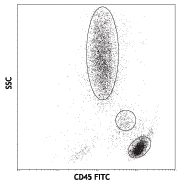
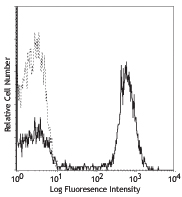

Compare Data Across All Formats
This data display is provided for general comparisons between formats.
Your actual data may vary due to variations in samples, target cells, instruments and their settings, staining conditions, and other factors.
If you need assistance with selecting the best format contact our expert technical support team.
-
Purified anti-human TCR γ/δ
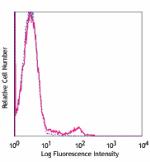
Human peripheral blood lymphocytes stained with purified B1,... -
Biotin anti-human TCR γ/δ
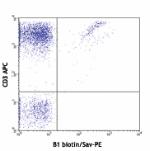
Human peripheral blood lymphocytes stained with CD3 APC and ... -
FITC anti-human TCR γ/δ
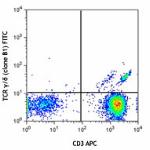
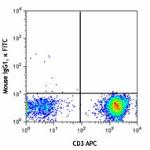
-
PE anti-human TCR γ/δ
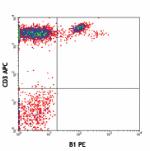
Human peripheral blood lymphocytes stained with CD3 (UCHT1) ... 
Confocal image of C57BL/6 mouse thymus sample acquired using... -
APC anti-human TCR γ/δ

Human peripheral blood lymphocytes stained with CD3 PE and B... -
Alexa Fluor® 647 anti-human TCR γ/δ

Human peripheral blood lymphocytes stained with CD3 PE and B... -
Brilliant Violet 421™ anti-human TCR γ/δ
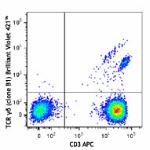
Human peripheral blood lymphocytes were stained with CD3 APC... 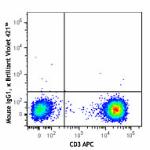
-
Brilliant Violet 510™ anti-human TCR γ/δ
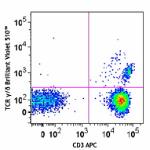
Human peripheral blood lymphocytes were stained with CD3 APC... 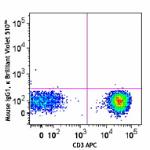
-
PE/Cyanine7 anti-human TCR γ/δ

Human peripheral blood lymphocytes were stained with CD3 FIT... -
PerCP/Cyanine5.5 anti-human TCR γ/δ

Human peripheral blood lymphocytes were stained with CD3 APC... -
PE/Dazzle™ 594 anti-human TCR γ/δ
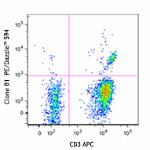
Human peripheral blood lymphocytes were stained with CD3 APC... 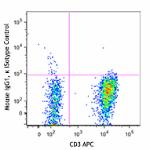
-
APC/Fire™ 750 anti-human TCR γ/δ
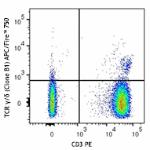
Human peripheral blood lymphocytes were stained with CD3 PE ... 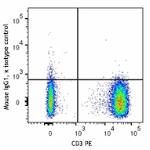
-
TotalSeq™-A0139 anti-human TCR γ/δ
-
TotalSeq™-C0139 anti-human TCR γ/δ
-
TotalSeq™-B0139 anti-human TCR γ/δ
-
Ultra-LEAF™ Purified anti-human TCR γ/δ

Human peripheral blood lymphocytes stained with purified B1,... -
PE/Fire™ 700 anti-human TCR γ/δ Antibody

Human peripheral blood lymphocytes were stained with anti-hu... -
Alexa Fluor® 660 anti-human TCR γ/δ Antibody

Human peripheral blood lymphocytes were stained with CD3 FIT... -
TotalSeq™-D0139 anti-human TCR γ/δ
-
PE/Fire™ 810 anti-human TCR γ/δ

Human peripheral blood lymphocytes were stained with anti-hu... -
Brilliant Violet 650™ anti-human TCR γ/δ

Human peripheral blood lymphocytes were stained with anti-hu... -
Brilliant Violet 785™ anti-human TCR γ/δ

Human peripheral blood lymphocytes were stained with anti-hu...
 Login / Register
Login / Register 













Follow Us